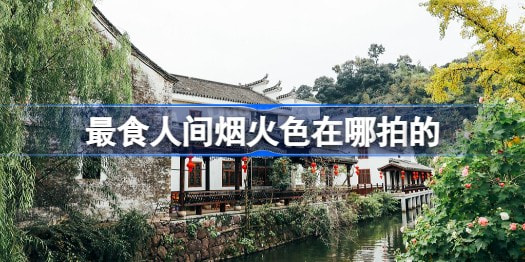The shooting locations in the drama "The Most Human-Eating Fireworks" are very beautiful. Many netizens want to know where the "The Most Human-Eating Fireworks" was filmed. Below, the editor will bring you an introduction to the filming locations of "The Most Human-Eating Fireworks". Read on.

Screenwriter Wang Xiaocui is from Wuyi. She said that this sentence in Fu Lei's family book was the original intention of the creation. Her drama depicts the female protagonist who is an urban white-bone demon and the male protagonist who is a male version of Li Ziqi. Through their emotional ups and downs, they explore their attitude towards life. Most people who work hard in big cities now are busy from 7 to 10 every day. The day has been so squeezed that the essence of life has been forgotten, and it has become more about survival. Urban syndrome has become the norm. This drama is not to criticize or satirize any attitude towards life, but to show another possible life. There is no big house in the city center, nor is there a boss with a luxury car, but there is music, pets, food, and a meal with friends, relatives, and loved ones on beautiful nights in all seasons.”
This work was created by recalling the life scenes in her hometown in Wuyi. I happened to be in my hometown when I was writing the script. When I went to Jingyuan with my parents, I learned their original intention of building the garden - to turn Jingyuan into a museum of old houses. This touched me very much, and it was also the reason why I chose to incorporate the special niche element of intangible cultural heritage into the script and story. "So, when she learned that the script would be filmed, she immediately recommended Wuyi's hometown as the filming location. Nowadays, many intangible cultural heritage items are disappearing and are forgotten outside the attention of young people. She hopes to use this work to arouse young people's interest in intangible cultural heritage culture. of attention.”
This is also a major reason that attracted the famous Hong Kong director Liang Guokuan to serve as the chief director. Old handicrafts are our wealth. In addition to healing sweet pets, this work incorporates many traditional handicraft settings, which is very mature and thoughtful. "
The plays directed by Liang Guoguan are mostly costume dramas, with relatively few modern dramas. This time the script has many collision points between ancient and modern environments and concepts. The film crew spent a long time in preparation and came to Wuyi many times to view the scenes. "Liang Guoguan said that the scenery of Wuyi is unexpectedly beautiful. Especially Jingyuan, there are ancient houses with flavor and stories, paired with plants with distinct seasons, as well as various animals such as wild ducks, white swans, tabby cats, and small puppies. There are many The elements of daily life are all present here. People and the environment, people and animals, people and craftsmanship collide and blend together. I am very satisfied with the result of the shooting. ”
When we were invited to interview, we just wanted to see what gave the screenwriter the idea of integrating traditional crafts into script creation. Unexpectedly, everyone didn't want to leave as soon as they arrived. "Lu Lu, the chief producer of the show, said that when he came to Jingyuan in April last year, everyone praised it as a worthwhile trip. Jingyuan has both the graceful scenery of Jiangnan and the grandeur, which is really rare.
The old house that was originally demolished and built has undergone many changes due to changes in the geographical environment. However, the aesthetics of living by the water and built against the mountains remain unchanged. The plum blossoms are red, the wicker branches are fluttering, the small bridge over the flowing water, the wild ducks playing in the water, the white swans chatting on the shore, the little white dog looking up at the warm sun in the house echoes the sound of the guqin, and the pine forests surrounding the mountains are also It seems to be connected to the horse head wall of every house...